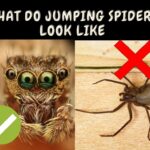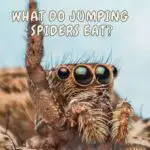Maevia inclemens is a distinct jumping spider with many excellent characteristics. This intelligent jumper belongs to the family Salticidae and is widely distributed throughout eastern North America. Because they love to hang out in the open, you’ll commonly sight them along tree lines in vines or hidden in ivy.
Like other jumping spiders we have come across, the Maevia inclemens is a voracious predator that will feed on small and large insects. Unlike other jumping spiders, the Maevia inclemens is the only spider to have dimorphic males. Interestingly, these two types of males differ in both courtship behavior and morphology. Read on to learn more about these exceptional characteristics not shared with other jumping spider species.
What is their scientific name?
Even though our furry friends are commonly referred to as dimorphic jumpers, they are scientifically called Maevia inclemens.
Besides their scientific name, Maevia inclemens has many unique characteristics we haven’t found in many jumping spiders. Thanks to their impeccable eyesight, which is more acute than those of dragonflies and cats combined, our spider friends can spot their prey from some distance away.
And because they can thrive in almost all environments, it’s easy to see why they are spotted on most continents.
Where do they come from?
Maevia incelemens is mostly found in the mid-west United States and the south-west of Canada. To be precise, our leaper friends have been sighted in Connecticut, Pennsylvania, Massachusetts, North Carolina, Texas, Alabama, Maryland, New Jersey, New York, Michigan, Wisconsin, Kentucky, Florida, and more.
There have been reported sightings of our spider friend in Manitoba and Quebec in the South-west of Canada. Outside of their natural habitat, our furry friends have been spotted in human-made structures. Most often, they have been sighted on outbuildings and structures like fences and walls.
Physical description and size
Maevia inclemens may not be the biggest jumping spiders out there, but guess what? It isn’t the smallest either. This medium-sized jumping spider has females that are slightly larger than males. To start with, females measure between 6.5 to10 mm, while their male counterparts measure between 4.8 to 7.0 mm in total body length.
Similarly, females look slightly different from males, and that’s because females have a predominantly white face with two black or red stripes visible down the back of their abdomen.
This species’ tufted morph features three tufts of hair on their head, with their body covered in black hairs while their legs appear white. On the flip side, the striped morph sports yellow pedipalps, black and white striped hairs on their legs, and a gray abdomen with a subtle touch of orange markings.
For now, it is almost impossible to know what factor can determine which morph a male will become. But hopefully, as studies progress into understanding this jumping spider species, we may see a breakthrough.
Courtship and unique behavior
Besides the noticeable differences in morphology, the two morphs of this jumping spider species display different courtship behaviors. To give you some perspective, the tufted males tend to court from a distance and stretch as tall as possible so that they can wave their abdomen from side to side.
On the flip side, the stripped males take a different approach to courting. When they want to mate, they simply approach the females at a much closer distance, crouch down while jerking back and forth.
And just like their male counterparts, females display similar courting behaviors to both morphs. While they may sometimes approach the males or settle close to them, other times, they may tap their first leg rapidly while waving their abdomen from side to side.
From available studies, females do not seem to display any preferences towards one morph. That said, it has been reported that females have a particular affection for larger tufted males and smaller striped males. And because the females are slightly bigger than the males, they have been observed to feast on courting males of both morphs.
What do they eat?
Our spider friends are voracious hunters who feast on small insects. On a starving day, they will take on larger insects like grasshoppers and little spiders of their kind. And because they are mainly carnivorous, they will prey on insects like flies, mosquitoes, mealworms, crickets, and web-building spiders. There has been reported evidence that Maaveia inclemens periodically eat nectar sources from flowers.
That said, when in captivity, they can no longer hunt or fend for themselves. Consequently, you have to provide your spider friend with feeder insects you can catch around your home or order from pets stores close to you.
What is their temperament?
Thanks to their friendly nature, jumping spider species like the Maevia inclemens are changing the ugly narratives and perceptions that people have about our furry friends. While they are vicious hunters who can hunt prey with utmost precision, they aren’t a threat to humans. And even when they come across humans, their first instinct is to get away.
Is it dangerous or venomous to humans?
While Maevia inclemens are venomous, their venom isn’t harmful to humans. Although a bite from this jumping spider may leave you with slight pain and irritations, not to worry; this will fade away after a couple of days.
Frequently asked questions
Can you keep Maevia inclemens as pets?
Generally, jumping spiders are friendly, so with the Maevia inclemens, you get more of the same. Thanks to their social nature, our leaper friends will make great pets. That said, you have to handle them gently so you don’t end up getting bitten.
How often should they be fed?
If you plan to keep jumping spiders in captivity, you have to make sure they feed correctly. Adult males should be fed once in three days, while juveniles can be fed every one to two days.
How big can they grow
Adult males of this jumping spider species measure between 6.5 to 10 mm, while adult females can reach between 4.8 to 7.0 mm.



